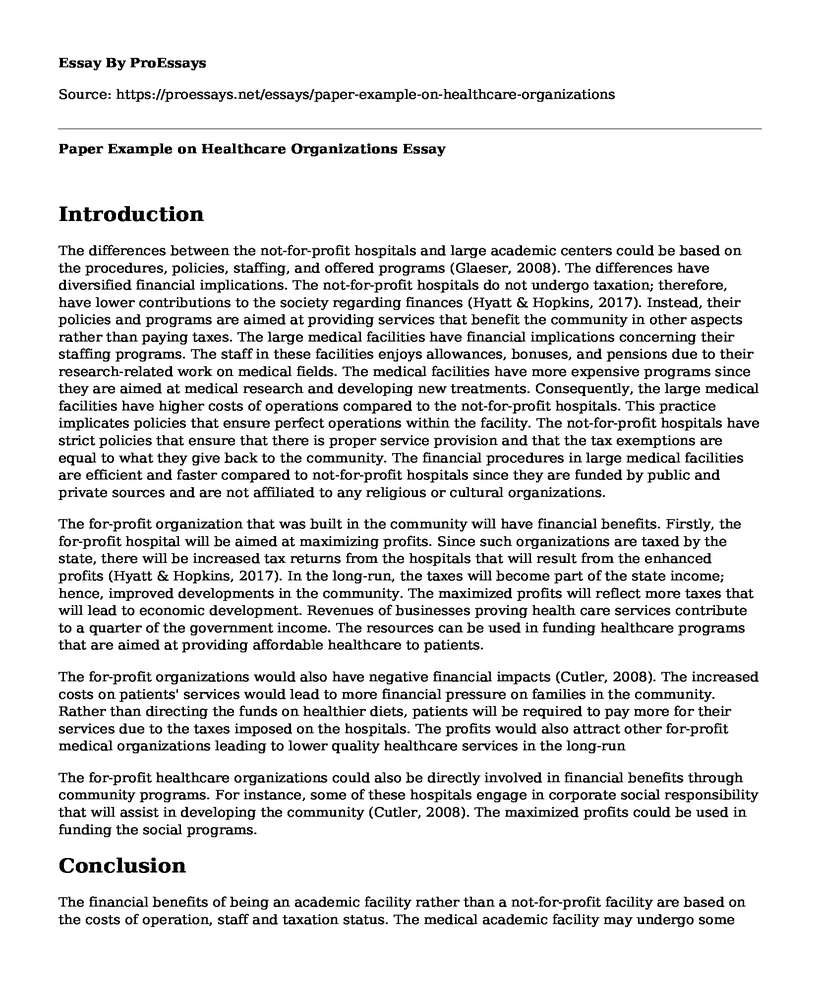Introduction
The differences between the not-for-profit hospitals and large academic centers could be based on the procedures, policies, staffing, and offered programs (Glaeser, 2008). The differences have diversified financial implications. The not-for-profit hospitals do not undergo taxation; therefore, have lower contributions to the society regarding finances (Hyatt & Hopkins, 2017). Instead, their policies and programs are aimed at providing services that benefit the community in other aspects rather than paying taxes. The large medical facilities have financial implications concerning their staffing programs. The staff in these facilities enjoys allowances, bonuses, and pensions due to their research-related work on medical fields. The medical facilities have more expensive programs since they are aimed at medical research and developing new treatments. Consequently, the large medical facilities have higher costs of operations compared to the not-for-profit hospitals. This practice implicates policies that ensure perfect operations within the facility. The not-for-profit hospitals have strict policies that ensure that there is proper service provision and that the tax exemptions are equal to what they give back to the community. The financial procedures in large medical facilities are efficient and faster compared to not-for-profit hospitals since they are funded by public and private sources and are not affiliated to any religious or cultural organizations.
The for-profit organization that was built in the community will have financial benefits. Firstly, the for-profit hospital will be aimed at maximizing profits. Since such organizations are taxed by the state, there will be increased tax returns from the hospitals that will result from the enhanced profits (Hyatt & Hopkins, 2017). In the long-run, the taxes will become part of the state income; hence, improved developments in the community. The maximized profits will reflect more taxes that will lead to economic development. Revenues of businesses proving health care services contribute to a quarter of the government income. The resources can be used in funding healthcare programs that are aimed at providing affordable healthcare to patients.
The for-profit organizations would also have negative financial impacts (Cutler, 2008). The increased costs on patients' services would lead to more financial pressure on families in the community. Rather than directing the funds on healthier diets, patients will be required to pay more for their services due to the taxes imposed on the hospitals. The profits would also attract other for-profit medical organizations leading to lower quality healthcare services in the long-run
The for-profit healthcare organizations could also be directly involved in financial benefits through community programs. For instance, some of these hospitals engage in corporate social responsibility that will assist in developing the community (Cutler, 2008). The maximized profits could be used in funding the social programs.
Conclusion
The financial benefits of being an academic facility rather than a not-for-profit facility are based on the costs of operation, staff and taxation status. The medical academic facility may undergo some subsidy programs compared to the non-tax benefits associated with the not-for-profit facilities. Notably, an academic facility has lower costs of operation since it is aimed at providing services to the medical students (Cutler, 2008). As a result, these facilities accrue the benefits of less financial costs. The not-for-profit facilities have a constant operating income that is based on the total costs that mostly include wages. In such a situation employee satisfaction in lower since there are no sources of income that could be used as incentives to motivate the employees. The medical center also enjoys monetary resources from both public and private sources that are invested in medical research to enhance healthcare provision (Hyatt & Hopkins, 2017).
References
Cutler, D. (2008). The Changing Hospital Industry: Comparing Not-for-Profit and For-Profit Institutions. Illinois: University of Chicago Press.
Glaeser, E. (2008). The governance of not-for-profit organizations. Chicago: University of Chicago Press.
Hyatt, T., & Hopkins, B. (2017). The Law of Tax-Exempt Healthcare Organizations 2017. Somerset: John Wiley & Sons, Incorporated.
Cite this page
Paper Example on Healthcare Organizations. (2022, May 23). Retrieved from https://proessays.net/essays/paper-example-on-healthcare-organizations
If you are the original author of this essay and no longer wish to have it published on the ProEssays website, please click below to request its removal:
- Paper Example on Non-profit Organizations
- Digital Disruptions in the Banking Industry Paper Example
- Essay Example on Master Budget: A Comprehensive Financial Plan for Organizations
- Asthma: Swelling, Wheezing, & Shortness of Breath - Essay Sample
- Essay Sample on Theories of Nursing: Concepts, Definitions, Models & Propositions
- Essay on Evaluating the Advantages of Fee-For-Service Payment for Healthcare
- EHR: Enhancing Clinicians-Patients Bond - Report Sample







